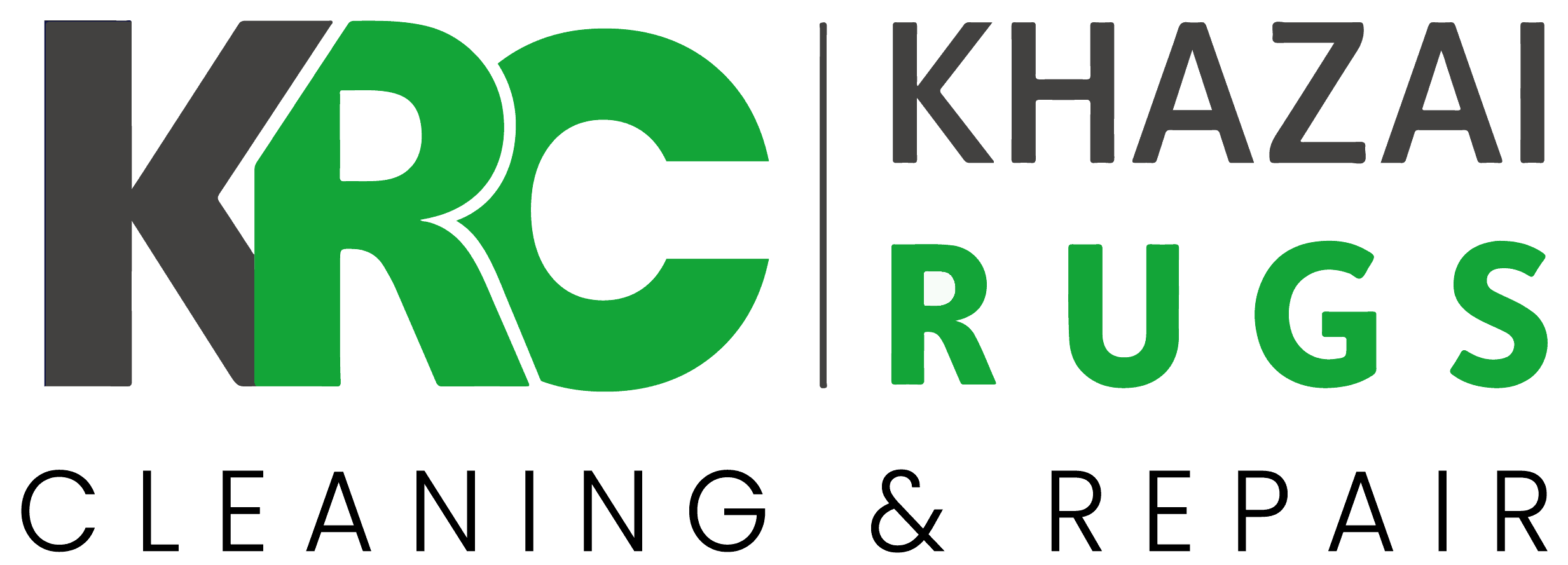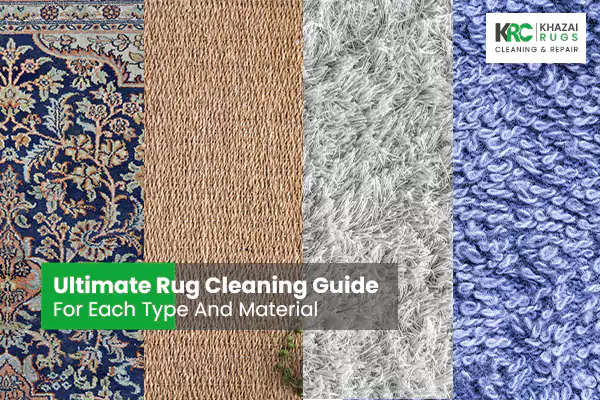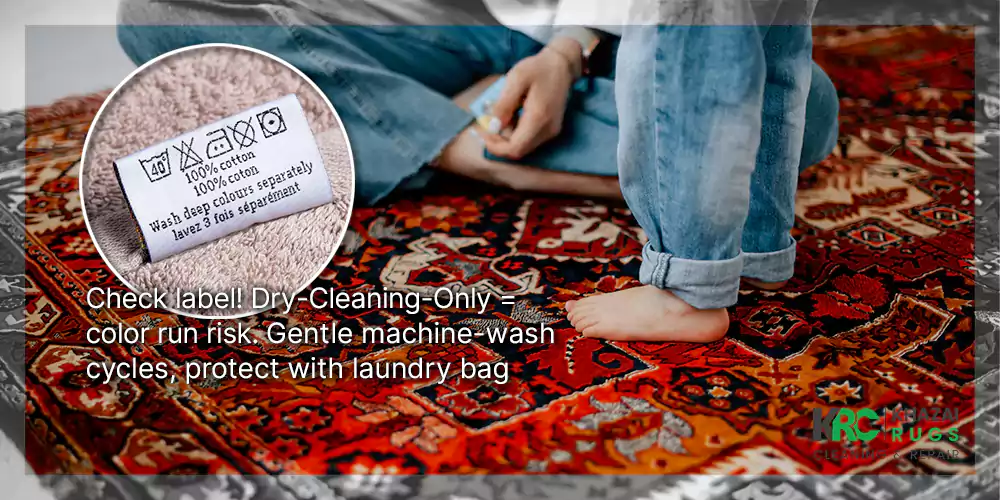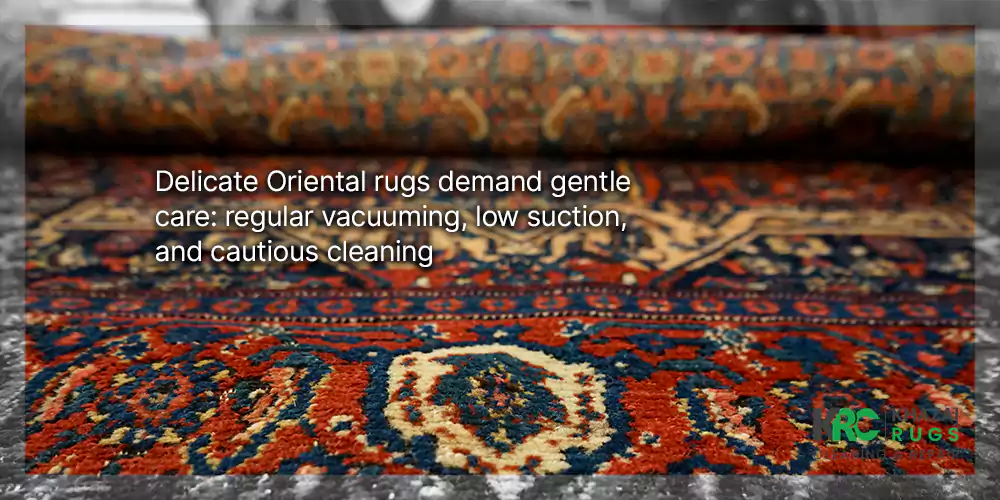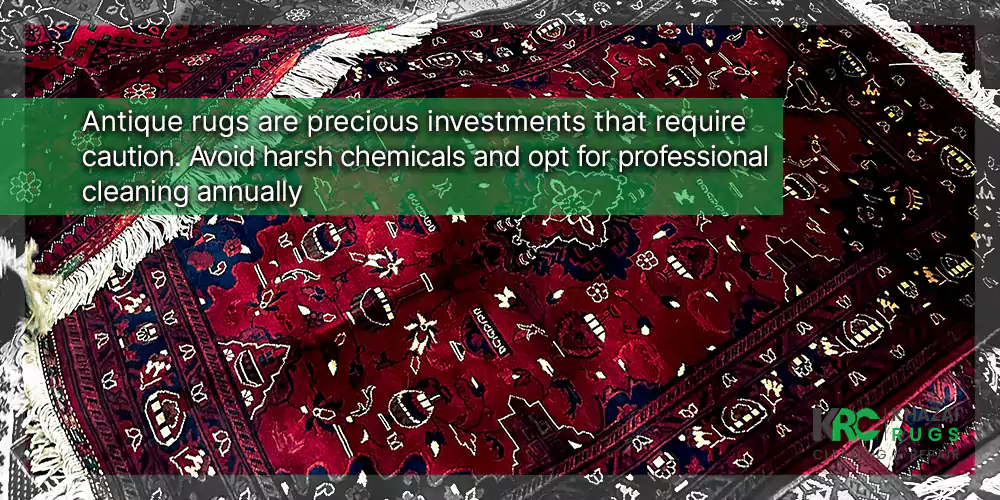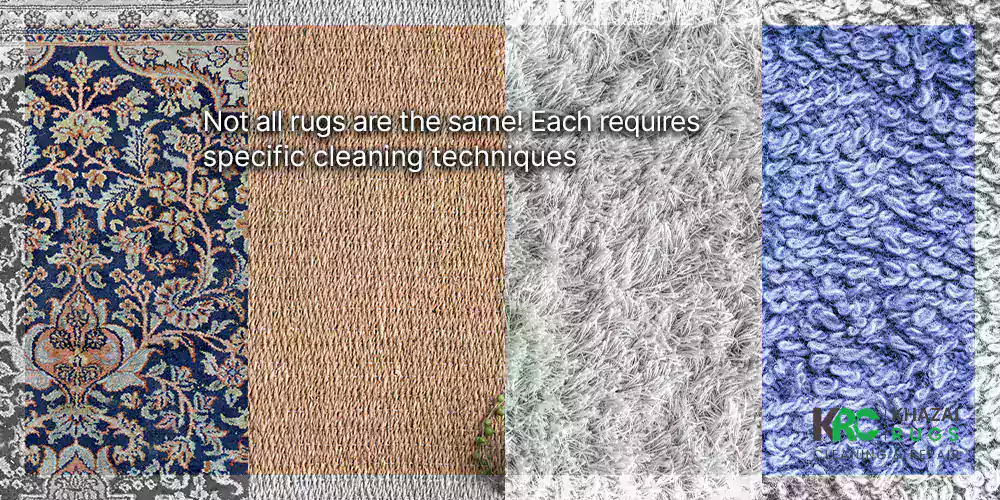
Ultimate Rug Cleaning Guide For Each Type And Material
As the term Rug describes a vast number of woven floor coverings, it might mislead you that there’s one general rug cleaning method that fits them all. But that’s not true, and doing so might cost you losing your precious rug. Rugs come in various materials and constructions, so each rug owner should maintain and clean them according to each rug’s specifications. Rug owners’ most common mistake is that they do not have the required knowledge and equipment to clean their rugs. Sometimes they get into the action themselves with DIY YouTube videos or leave their rugs to unprofessional cleaning services that ruin the priceless poor rug. This article will give the essential information that any rug owner needs before they ask a company for professional rug cleaning.
How Many Rug Types Are Out There?
Each rug, especially the handmade ones, is quite specific and one-of-a-kind, but there are some criteria with which we can categorize rugs into distinct groups. These include a rug’s material, age, construction type, and origin. For instance, handmade and machine-made are the two largest categories that refer to the rug’s construction process. Moreover, that material could be natural-based such as wool, cotton, silk, sisal, and jut; or the low-cost synthetic alternatives like viscose, propylene polypropylene.
The rug’s age is also a notable role player. If it has managed to pass 100 years of age, it would be labeled as Antique. That label brings significant value to the rug. Still, it also means that the rug is probably fragile, which means treating and cleaning it with absolute care. In the following, we’ll dive into the specific tips you’d better keep in mind before starting the rug cleaning process.
Take These Into Consideration Before You Order A Rug Cleaning Service
First, look at the rug’s label to see how it should be cleaned depending on the material. For example, a Dry-Cleaning-Only label tells us that the rug’s color might run if washed incorrectly. If the rug is compatible with machine-washing, make sure the cycles are gentle and the fringes are wrapped with a plain-color string. That will prevent tangling the long fringes. As already mentioned, put the rug in a laundry bag to protect it.
Then, hang the washed rugs, just like how you hand your washed clothes. Ensure the wet rug is straightened while hanging; otherwise, it will deform after drying out.
Handmade area rugs will keep their glamour perfectly if professionally cleaned every year. But before using any commercial detergent, test it on a small area in the corner of the rug to see how it reacts.
How to Clean Machine-Made Rugs

As self-explanatory, machine-made rugs are constructed by giant electric devices called Power Loom. These rugs are commercial and mass-produced to be affordable for the majority of the customers. Moreover, the producers use chemical-based and low-cost materials for the machine-made rugs to minimize the costs as much as possible. That’s why they lack any artistic value like that of handmade rugs.
But affordability doesn’t mean low-quality for machine-made rugs at all. They have quite a resistant structure that tolerates heavy furniture, constant foot traffic. Thanks to their rigid nature, you could feel free to use chemical detergent for cleaning them. All in all, machine-made rugs are relatively more resistant and easier to clean. Most of machine-made rugs are made of viscose, and it’s highly recommended to get them an expert Viscose Rug Cleaning at least every two years.
How to Clean Oriental Rugs

The delicate natural materials such as wool and cotton that are used in Oriental rugs are quite delicate. They are soft, colorfast, and surprisingly durable if maintained properly. The bad news is that the natural fibers are bug magnets. These wicked invaders look at your artistic Oriental rug like the “Land of Candy” in Charlie and the chocolate factory!
The fibers’ delicacy means Oriental rugs easily ruin if cleaned inadequately. You’d better vacuum them at least once a week. Remove the vacuum brush to avoid the rug fringe from getting stuck. Always keep in mind to use the low suction while cleaning hand-knotted Oriental rugs.
Most of the DIY Youtube guides and amateur rug cleaners only take care of the surface and fail to remove the massive amount of dirt and dust stuck in the rug’s foundation. This deep-stuck dirt not only gives a repelling stink to your charming rugs but also ruins the rug in the long run by inviting bugs, mold, and mildew to the rug’s foundation.
So the best is to get an expert Oriental Rug Cleaning and Repair service at least every year, conducted by a well-experienced Rug Expert who is comprehensively familiar with each rug and its specifications to clean them correctly without bringing any damages to them.
Antique Handmade Rugs
Antique rugs are the most admired ones. You could look at them as knotted investments on your floor that never lose value over time and gain even more. So just like how you take good care of the cash and gold bars in your safe, you’d better be cautious while cleaning your high-priced antique rugs.
First and foremost, forget about the conventional cleaning detergents you find on the supermarket shelf. Their harsh chemicals unbalance your delicate handmade rug’s pH level, leading to color bleeding and burning the natural fibers. It’s quite risky to clean them at home, so it’s highly recommended to get a professional Antique Rug Cleaning at least every year.
It would be best if you be careful about leaving your rug to a cleaning company. Check the company’s expertise, background, and cleaning methods thoroughly to ensure your precious antique rug is in the right hands. The company in charge of Antique Rug Cleaning must have certified and qualified Rug Experts who have the required knowledge and experience to treat a delicate antique rug. They also should give you insurance on the pricey hand-knotted investment you leave to them.
Shag Rugs
Shag rug cleaning services are easily noticeable with their long, thick, and plush piles. It’s challenging to reach the rug’s depth, where so much dirt and dust are hiding from the vacuum cleaner. Never use the high airflow on the cleaner because it might tear up the piles. It would be best if you flip the shag rug and vacuum its back as well; that will loosen the stubborn deep-stuck dirt.
Try not to use vacuum cleaners on the shaggy as much as you can because either way, it will loosen and damage the rug’s long piles.
A proven method is to soak entirely into the water to get the dust and dirt particles completely out. This method is most probably not possible in your home, so it would be best if you get an expert Shag Rug Cleaning at least every 12 months.
Rugs with Plant-Based Material
Some rugs are made of plant-based material like coir, sisal, and rush. They are sustainable and the best option for those having environmental interests. These eco-friendly rugs have relatively opener weaves, which allow dust and dirt to stick in the foundation. So vacuum these rugs and the underneath floor frequently. If the rug is reversible, turn it over each time after vacuuming.
In case of stain incidents with these rugs:
- Put a towel or cloth underneath to protect the floor.
- Soak the stained area in a home-made soapy solution.
- Scrub the stain crumbs gently with a soft brush.
- Put a dry towel or cloth on the wet area and keep dabbing it to absorb all the excess water.
The best thing about these natural-fiber rugs is that they are made of small squares sewn together. In other words, you could buy and save some spare squares to use when a part of your rug is damaged beyond repair.
For more information on how to treat each stain incident, visit our Stain Removal Guide.
Sheepskin Rugs
Some rugs are constructed of fur, hide, or skin of animals such as sheep and cows. When cleaning these rugs, don’t forget to pour talcum powder all over the surface and let it sit for a couple of hours. Next, brush the talcum powder into the texture, shake the rug to get the powder out. Dip a piece of cloth in a warm soapy solution and clean the rug’s back with it. Finally, rinse the stained area with a deep-wet cloth and let it entirely dry out before putting it back in the room.
Flatweave Rugs
A flatweave rug is an ideal option for busy people who have no time to maintain and clean their rugs. That is because of their relatively thin and flat texture, which does not attract much dust and dirt, and gets easily cleaned by a simple vacuum cleaning.
How Does Rug Type Affect Cleaning Methods?
The type of rug you have can significantly affect the cleaning methods you should use. Different rugs are made from various materials and construction techniques. So, they may have different cleaning requirements to maintain their appearance and integrity. Here’s how rug type affects cleaning methods, considering the key points you mentioned:
- Size and location: The size and location of the rug can determine how easy it is to move and lean. Larger, heavier rugs may require more effort to clear the surrounding area and safely maneuver during cleaning.
- Pile type: Rugs come in various pile types, including low pile, high pile, and everything in between. The type of pile affects how dirt and debris are trapped. High-pile rugs tend to trap more dirt deep within the fibers, making thorough vacuuming essential.
- Fiber material: The material the rug is made from, such as wool, silk, cotton, or synthetic fibers, can influence how it should be vacuumed. Delicate fibers like silk may require gentler vacuuming to prevent damage.
- Dye stability: Different rugs have varying degrees of colorfastness, which is the ability of the dyes to resist fading or bleeding when exposed to cleaning solutions or water. Natural fiber rugs like wool may be more prone to color bleeding than synthetic rugs.
- Stains and damage: The type of rug also affects its susceptibility to stains and damage. For example, delicate silk rugs are more easily damaged by aggressive cleaning methods, while durable synthetic rugs may tolerate more robust cleaning approaches.
Always consider the unique characteristics of your rug when planning your cleaning routine to ensure its longevity. If you’re uncertain about the appropriate cleaning methods, consult with a professional rug cleaner or refer to manufacturer guidelines.
How to Handle Special Cases and Delicate Materials?
Handling special cases and delicate materials, such as silk and delicate fiber rugs, requires extra care and attention to preserve their value. Here are some rug cleaning tips for these special cases:
- Silk and Delicate Fiber Rugs:
- Avoiding excessive moisture: Silk and delicate fiber rugs are highly sensitive to moisture. Avoid over-wetting the rug during cleaning, as excessive moisture can cause the fibers to weaken or color bleeding.
- Gentle vacuuming: Use a low-suction vacuum cleaner or a brush attachment to gently remove surface dust and debris. Avoid aggressive vacuuming that may pull or snag delicate fibers.
- Spot cleaning: For stains, use a mild detergent mixed with water and apply it sparingly to the stained area. Blot (do not rub) with a clean, white cloth to lift the stain. Test any cleaning solution in an inconspicuous area first to check for colorfastness.
- Professional cleaning: Silk rugs should be professionally cleaned by experts with experience in handling delicate fibers. They can use specialized cleaning methods and equipment to avoid damage.
- Antique and Heirloom Rugs:
- Dust removal: Antique rugs should be gently shaken or lightly beaten outdoors to remove loose dust and debris. Do not use excessive force, as this can cause the rug to weaken.
- Avoiding DIY cleaning: Antique rugs are often fragile, and attempting to clean them yourself can lead to irreversible damage. Consult with a professional rug cleaning service with experience in handling valuable and delicate rugs.
- Restoration: Antique rugs may require restoration work, such as repairing frayed edges, reweaving damaged areas, or addressing color fading. Trust this work to experts in antique rug restoration.
- High-Pile and Shag Rugs:
- Regular shaking: Shaking out high-pile and shag rugs outdoors can help dislodge dust and debris trapped deep within the fibers.
- Using a specialized vacuum attachment: High-pile and shag rugs benefit from vacuuming with a beater bar or brush attachment. Ensure the vacuum has adjustable settings to avoid excessive suction, which can damage the rug.
- Rotating the rug: To prevent uneven wear, regularly rotate the rug so that foot traffic is distributed evenly.
- Professional cleaning: High-pile and shag rugs may accumulate hidden dirt and dust. So, they require professional cleaning every 12 to 18 months, depending on use.
Regardless of the type of special case or delicate material, always consider the following general guidelines:
- Read and follow the manufacturer’s care instructions if available.
- Perform a colorfastness test before using any cleaning solution.
- Blot stains instead of rubbing to prevent spreading and damage.
- When in doubt, consult a professional rug cleaner who specializes in the specific type of rug you have.
What Are the Best Rug Cleaning Tips for Drying and Post-Cleaning Care?
Proper drying and post-cleaning care are crucial to ensure your rugs remain clean, fresh, and in good condition after cleaning. Here are some essential tips:
- Whenever possible, allow rugs to air-dry outdoors in a shaded area with good air circulation.
- Hang the rug over a sturdy railing or clothesline. Avoid direct sunlight, as it can fade colors and damage natural fibers.
- Periodically flip and rotate the rug while drying to ensure even drying on both sides.
- Also, use fans or dehumidifiers indoors to expedite the drying process. Ensure proper ventilation to prevent moisture buildup.
- Ensure rugs are completely dry before bringing them back indoors. Any residual moisture can lead to mold and mildew growth.
- Regularly vacuum and clean your rugs to prevent the accumulation of dirt and moisture.
- After the rug is completely dry, use a soft-bristle brush or rug comb to gently fluff and restore the pile or fibers.
- Grooming can also help maintain the rug’s appearance. Use a rug rake or brush to straighten out any flattened areas or matting caused by foot traffic.
- If you plan to store rugs for an extended period, ensure they are clean and completely dry before rolling and storing them.
- Store rugs in a dry, cool, and well-ventilated area.
With these drying and post-cleaning care tips, you can help prolong the life of your rugs. Most importantly, you will be able to prevent issues like mold and mildew growth. Proper care ensures that your rugs continue to enhance the aesthetics and comfort of your living spaces for years to come.
Where To Find The Best Rug Cleaning in Washington DC?
At Khazai Rug Cleaning, your rugs take a comprehensive 10-step journey to win their value and charm back. Our staff’s exceptional knowledge and expertise, enriched by five generations of being in the rug industry, guarantees your precious rugs to look good-as-new after leaving our Rug Repair and Rug Cleaning process.
Stain and wear-out damages should not let you down on your elegant rugs because our Rug Experts are ready to root out any stain with the top-grade Rug Cleaning in Washington DC!
If you have any issues with your rugs, feel free to give us a call for a free consultation and appointment.

